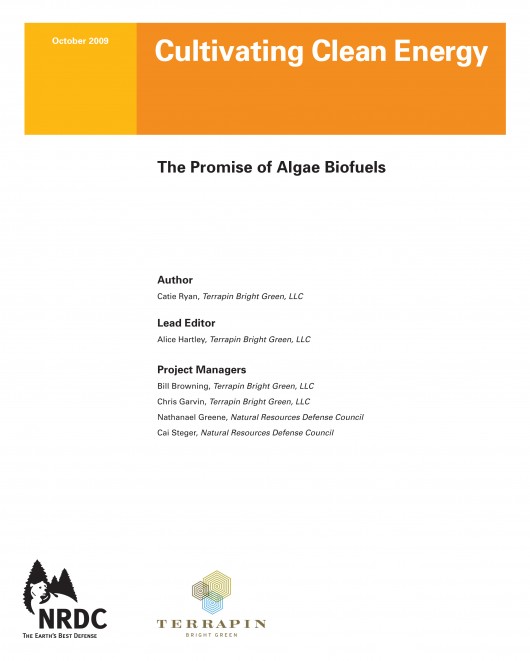Report
Cultivating Clean Energy
The promise of algae biofuels
ABSTRACT
Biofuels derived from algae have been touted by some as a path to a sustainable energy supply. It is hoped that the lipids and hydrocarbons produced by algae can be converted into a variety of fuels at a more efficient rate per acre than conventional biofuel sources. However, a consensus has not yet been reached on the scope of impact algae-to-biofuel production may have on the environment. Understanding the relationship of production processes, inputs, and outputs with environmental issues, such as energy balance, water resource management, land-use impact, and environmental benefits and unknown impacts, will help direct decision making for securing a truly sustainable fuel source.
At the request of Natural Resources Defense Council (NRDC), Terrapin examined the algae-to-biofuel production processes—cultivation, harvesting, oil extraction, conversion, and product distribution—and identified the critical challenges to making algal biofuels a significant and sustainable source for our aviation and other transportation energy needs.
The October 2009 report, entitled “Cultivating Clean Energy: The Promise of Algae Biofuels”, has been identified in the U.S. EPA Renewable Fuel Standard Program’s Final Regulatory Impact Analysis (February 2010) as “a good resource for understanding the basic pathways for algae-based biofuels and summarizes some of the areas that can be improved to further commercialization of algae-based biofuels.” The report was also cited in the EPA’s first Triennial Report to Congress on “Biofuels and the Environment” (January 2011). In May 2010, Biofuel Digest noted that the Report holds a record for the most downloaded on their website – over 30,000 times and about 10,000 more than the second most downloaded report.
Inside This Report
Introductory Letter
Executive Summary
Chapter 1: Potential Environmental Impacts of Algae-to-Biofuel Production
Chapter 2: Mapping Pathways for Algae-to-Biofuel Production
- Algae-to-Biofuel Production Pathways: Maps A–E
Chapter 3: Exploring the Stages of Algae-to-Biofuel Production
- Algae Cultivation
- Biomass Harvesting
- Algal Oil Extraction
- Oil and Residue Conversion
Chapter 4: Conclusions and Recommendations
Appendices
- Appendix A: Historical Overview of Algae Biofuel Research and Development
- Appendix B: Discussion of Genetically Modified Algae
Acronyms
Glossary of Terms
Endnotes
Additional References
About NRDC
The Natural Resources Defense Council (NRDC) is a national nonprofit environmental organization with more than 1.3 million members and online activists. Since 1970, our lawyers, scientists, and other environmental specialists have worked to protect the world’s natural resources, public health, and the environment. NRDC has offices in New York City, Washington, D.C., Los Angeles, San Francisco, Chicago, Montana, and Beijing.
Acknowledgements
This report was carried out from July 2008 to June 2009 for the Natural Resources Defense Council (NRDC) under the sponsorship of the Gordon and Betty Moore Foundation (Palo Alto, CA). Preparation was supervised by NRDC and Terrapin Bright Green and conducted with the advice and assistance of the NRDC Algae Biofuels Advisory Committee. The authors would like to thank them for their valuable contributions. The authors would also like to thank Avery Hairston for his proofreading assistance. The opinions and conclusions in this report are solely those of the authors and do not necessarily reflect the views of the sponsoring or supervising agencies.
NRDC Algae Biofuels Advisory Committee
- Andy Aden, Biorefinery Analysis, Biomass Research, NREL
- Walter Adey, Curator of Algae, The Smithsonian Institute
- Al Darzens, Applied Science, Biomass Research, National Renewable Energy Laboratory (NREL)
- TJ Evans, U.S. Department of Agriculture (USDA)
- Arthur Grossman, Department of Plant Biology, The Carnegie Institution
- Jennifer Holmgren, Director of Renewable Energy and Chemicals, UOP LLC, a Honeywell Company
- Patrick Kangas, Department of Environmental Science and Technology, University of Maryland
- Jack Lewnard VP and Chief Technology Officer, Gas Technology Institute
- Stephen Mayfield Department of Cell Biology, The Scripps Research Institute
- Dave McLaughlin Managing Director and VP of Agriculture, World Wildlife Fund (WWF)
- Evan Smith Co-founder and Partner, Verno Systems Inc.
- Milton Sommerfield School of Life Sciences, Arizona State University

